More on this book
Community
Kindle Notes & Highlights
Self-objectification occurs when people learn to view their own bodies from an outside perspective, which is a natural result of living in an environment where bodies are objectified.
When we are self-objectifying, our identities are split in two: the one living her life and the one watching and judging her. We become our very own self-conscious identical twin, an onlooker to ourselves, monitoring how we look rather than how we are feeling or what we are doing. We live, and we imagine how we look as we live, adjusting and contorting ourselves accordingly. We watch from afar as our bodies become our primary means of identity and value.
Our feelings about and perceptions of our bodies—our body image—become warped into our feelings about how we appear to ourselves and others. We learn that the most important thing about women is their bodies, and the most important thing about women’s bodies is how they look.
In our objectifying culture, in which a high priority is placed on appearance and in which some bodies are praised and valued while others are degraded and marginalized, your body image—your feelings about your body—is informed by a lifetime of messages tying a woman’s worth to her appearance. Those same messages define what it looks l...
This highlight has been truncated due to consecutive passage length restrictions.
Women who feel positively about their bodies because of how they look often fall even harder into negative body image and shame when they no longer live up to the ideal, whether because of aging, illness, pregnancy, or any other cause. When your main source of confidence and validation isn’t producing the same results it used to, that loss stings.
Women are privileging an external view of their bodies over their own internal, first-person perspective. It’s as if we, as women, exist outside of ourselves—as if our bodies can be understood only through someone else’s eyes.
Positive body image isn’t believing your body looks good; it is knowing your body is good, regardless of how it looks.
When we can understand and relate directly to our bodies by experiencing our physical selves from the inside, rather than maintaining a limited outside perspective, we can see more in our bodies and ourselves—more than a body to be looked at, judged, consumed, and discarded.
But experiencing and valuing yourself as a whole, embodied human means making sure you aren’t prioritizing validation from others above your own well-being, health, and happiness, and not prioritizing an external perspective of who you are.
While we have little control over the way others view and value us and the objectifying, dehumanizing, and demeaning environment that surrounds us, we do have control over the ways we respond to the pressures and pains that result.
In a culture that values some bodies and faces more than others, we recognize that some people confront much more significant barriers to developing a positive body image and pushing back on their own objectification. This is particularly true around intersections of race, ethnicity, gender and sexuality, class, ability, and body size that affect how people experience the world and how the world perceives their bodies.
None of us is immune to the harms of objectification, but it is important to acknowledge our own advantages that help alleviate the harshest aspects of that pain in our lives.
You hate your body instead of hating the expectation that your body fit a certain mold. You hate your weakness and lack of discipline instead of hating the profit-driven solutions that are designed to require a lifetime of purchases but still leave you short of perpetually out of reach ideals.
Difficult experiences and feelings about your body caused by objectification can work for you instead of against you.
My body was never the problem; my perception of my body was the problem.
Your body is your home. Your ultimate comfort. Your respite. Yours and no one else’s.
Girls get the message, from very early on, that what’s most important is how they look, that their value, their worth depends on that. Boys get the message that this is what’s important about girls. We get it from advertising, we get it from films, we get it from television shows, video games—everywhere we look. So no matter what else a woman does, no matter what else her achievements, her value still depends on how she looks. —Jean Kilbourne,
In media, including social media, children’s movies, and even the local news, women are represented far too often as pretty parts served up on a platter. Not thinking, feeling humans, but bodies to be consumed.
Most media messages about women’s bodies are based on the idea that our happiness, health, power, and relationship status depend upon our consumability—how good we look to others and how irresistibly sexy we are.
Advertising targeted at girls and women largely relies upon us believing two things: 1) our happiness, health, and ability to be loved are dependent on our appearance; and 2) it is possible to achieve physical ideals—and thus become worthy of happiness, health, and love—with the help of the right products or services.


